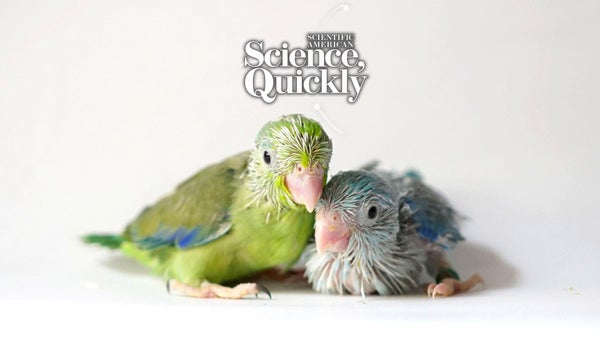Karen Hopkin: This is Scientific American’s Science, Quickly. I’m Karen Hopkin.
Little kids say the most nonsensical things, like my son at the aquarium when he was two or three.
[CLIP: Toddler talking about fish]
On supporting science journalism
If you're enjoying this article, consider supporting our award-winning journalism by subscribing. By purchasing a subscription you are helping to ensure the future of impactful stories about the discoveries and ideas shaping our world today.
Toddler: “They say bloop bloop. I think that one and this one are saying bloop bloop”
Hopkin: Even sweeter are the sounds they make when they’re just beginning to explore their vocal capabilities.
[CLIP: Baby babbling]
Hopkin: But human babies are not unique—at least when it comes to this sort of inarticulate articulation—because a new study shows that baby parrots also babble before they leave the nest. The findings appear in the journal Proceedings of the Royal Society B: Biological Sciences.
Karl Berg: When baby humans are babbling, they’re kind of stringing a bunch of sounds together in sort of unintelligible ways. There’s no identifiable context.
[CLIP: Baby human babbling]
Hopkin: Karl Berg is an associate professor of biology at the University of Texas Rio Grande Valley. He says parrot babble is really very similar.
Berg: Gibberish is a good descriptor.
[CLIP: Parrotlet babbling]
Berg: They’re kind of mixing everything together, and it seems like they’re regurgitating everything they’ve ever heard before.
Hopkin: Berg and his colleagues have been studying a species of parrot called the Green-rumped Parrotlet in Venezuela.
Berg: We’ve been intensively monitoring the population. We’re in our 35th consecutive year this year.
Hopkin: The researchers positioned video cameras inside the birds’ nests. But it took them a while to notice the baby parrots running through their vocal warmups.
Berg: We initially missed it because when we first started filming inside the nest cavities, all of the action and all the interesting things seemed to be happening when the parents would arrive.
Hopkin: That prompts the babies to start clamoring for food. But when their parents are away, the nestlings take turns napping, preening each other and talking to themselves.
Berg: Oftentimes the other siblings are asleep.
Hopkin: And they keep up this peeping and cheeping even after those siblings have flown the coop, leaving them the last little parrotlet left in the nest.
Berg: So they’re spending endless hours in there alone, and they do look kind of bored, and we see babbling then as well.
Hopkin: This nestling nattering differs from adult conversation in that it’s a little lackadaisical—and very, very quiet.
[CLIP: Parrotlet babbling]
Berg: If you’re standing just a few feet from the nest, I suspect you would not hear it.
Hopkin: Whereas mature calls are much faster paced ...
[CLIP: Mature parrotlet call]
Hopkin: And generally more strident.
Berg: Parrots are kind of known for being noisy and loud.
[CLIP: Pair of parrotlets dueting]
Hopkin: Keeping these experimental vocalizations to a whisper makes sense if you want to avoid attracting predators to your nest. And South American parrots are not the only ones that do it. Berg has since found that the babies of another type of parrot, one that lives in Mexico and southern Texas, also babble—in work he’ll be presenting at the Animal Behavior Society’s annual meeting this summer.
[CLIP: Parrot babbling]
Hopkin: Now, as to what all this babbling is about, Berg says it’s not likely a form of social communication, because the birds often do it when no one else is listening.
Berg: A better explanation for what they’re doing is: they’re practicing and possibly adjusting the way they make certain calls as they get a better handle on what they’re hearing, presumably by watching and listening to adults as they interact.
Hopkin: So, in addition to producing the standard “feed me” chirps, the babies are tossing out contact calls like the ones adults use to coordinate their movements, alarm calls like the ones that ring out when a parrot spots a snake or a hawk and warbling calls that are produced to defend the nest. But in babbling, all these calls are just sort of jumbled together without any readily identifiable purpose or context. It’s like a rehearsal for when the birds really do have nests to defend, behaviors to coordinate and predators to warn about.
Berg: So babbling is a medley, a tossed salad of all these different calls that either are already or will eventually be used in more specific functional contexts.
Hopkin: Berg also found that a babbling parrot’s playlist can be boosted by steroids.
Berg: By giving a modest dose of corticosterone to nestlings twice a day for a week, we were able to show that the corticosterone-treated nestlings had a larger repertoire.
Hopkin: That makes sense because stress hormones are key to coordinating a baby bird’s growth and maturation. Now, as to whether having a more extensive songbook might be beneficial ...
Berg: It’s quite possible. A large repertoire in songbirds has been shown to be advantageous in numerous ways related to reproduction.
Hopkin: To find out if the same is true for parrots, Berg will continue to observe his oldest feathered friends.
Berg: One way we can figure that out is by continuing the long-term ecological monitoring, where we capture essentially every individual in the population and put unique color bands on them.
Hopkin: That way Berg and his colleagues can assess whether the parrots who had the widest vocabulary in their baby days ...
Berg: Are the movers and shakers in parrotlet society today ...
Hopkin: At least as evidenced by their reproductive success, which would be something to crow about.
[CLIP: Adult Green-rumped Parrotlet calls]
Hopkin:Science, Quickly is produced by Jeffery DelViscio, Tulika Bose and Kelso Harper. Subscribe wherever you get your podcasts and visit ScientificAmerican.com for updated and in-depth science news.
[Clip: Show theme music]
For Scientific American’s Science, Quickly, I’m Karen Hopkin.

